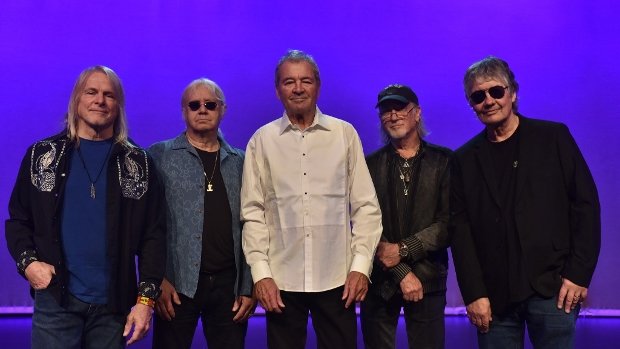

Ritchie Blackmore detailed his decision to step away from Deep Purple in the ‘90s and pursue the more traditional folk-rock project Blackmore’s Night, explaining that he had grown bored with the travails of playing in a world-famous hard rock band.
The guitarist left Deep Purple for good in 1993; he then briefly rebooted Rainbow before starting Blackmore’s Night with singer (and now-wife) Candice Night in 1997.
As Blackmore recently explained to New Jersey Stage: “The stress was from the traveling to do with rock ’n’ roll, the continual trying to come up with different augmentations of heavy riffs, which can be boring. I was getting stale playing the same type of music: heavy rock for the sake of playing heavy rock.”
After spending several decades with the group he co-founded and writing some of the most enduring hard rock and metal anthems in history, Blackmore felt compelled to dive headfirst into another passion: traditional medieval music.
“I have always been interested in melodic rock — melodies in general,” he said. “Toward the end of Purple, it was just being loud for the sake of being loud, so when I heard renaissance music, there were so many incredible melodies that struck a chord with me.
That was such a relief in many ways, so I jumped off the monster train just to play some melodies more organically.”
READ MORE: When Ritchie Blackmore Melted Down Onstage at a Deep Purple Show
Blackmore’s Night Offered an Escape From the Music Industry
Night — who contributed to Rainbow’s 1995 album Stranger in Us All prior to the formation of Blackmore’s Night, and who married Blackmore in 2008 — added that Blackmore’s Night provided an escape from the pressures of the music industry for the titular guitarist.

“It really began as a personal journey and escape from what the rock ’n’ roll world had become for Ritchie in the late ‘90s,” she said.
“Having had such success in the ‘60s and throughout [the ‘70s and ‘80s], he was used to creative freedom and individuality of bands.
But by the late ‘90s, when he reformed Rainbow, the corporations wanted approval over everything. Record companies wanted a say in titles of songs, demos to hear the direction of the album. It wasn’t what he was used to dealing with at all.
“So, while the other band members in Rainbow were doing their tracks, we were sitting fireside in a farmhouse studio in Massachusetts, playing acoustic guitar and writing songs for our own pleasure,” she continued.
“When our friends heard them and said they loved them was when we decided to put them out for the rest of the world.
But it continues to be a path of stress release from the pressures of society and form of escapism — not only for us when we are creating the music, but for those listening to it as well.”
A proposed supergroup from the start, Deep Purple was assembled around the talents of classically trained organ player Jon Lord (late of the Artwoods) and guitarist Ritchie Blackmore, a stage and session ace whose resume already included names like Screaming Lord Sutch, the Outlaws and eccentric producer Joe Meek.
After dispensing with original percussionist Chris Curtis and the formative band name of Roundabout, the twosome recruited bassist Nick Simper (of the Flower Pot Men) and singer Rod Evans (of the Maze), who brought with him teenage drummer Ian Paice.
Deep Purple Mk. I recorded three albums, experienced an immediate U.S. breakthrough with their cover of Joe South’s “Hush,” but then seemed in danger of becoming a one-hit wonder due to mounting business, personal and creative issues — all of which brought them to a premature career crossroads.
By the summer of 1969, Blackmore, Lord and Paice were in agreement that changes in both sound and personnel were needed for there to be any hope of relaunching Deep Purple’s career.
They replaced Evans and Simper with Episode Six singer Ian Gillan and bassist Roger Glover, whom they felt were better equipped to pursue a heavier new direction.
Sure enough, following a brief detour into symphonic rock for Lord’s ambitious ‘Concerto for Group and Orchestra,’ the rookie duo proved to be perfect catalysts. ‘In Rock,’ ‘Fireball’ and ‘Machine Head’ are still lauded as cornerstones of hard rock and heavy metal.
Still, Deep Purple’s so-called Mk. II lineup would soon buckle under the pressure of creative differences and non-stop work.
After cementing their legend with 1972’s ‘Made in Japan,’ and cutting 1973’s clearly less inspired ‘Who Do We Think We Are?,’ Gillan and Glover exited, leaving Blackmore, Lord and Paice to consider their next move.
Another pair of complementary musicians arrived in former Trapeze bassist and vocalist Glenn Hughes and a relative unknown lead singer by the name of David Coverdale. Mk. III immediately recovered their top form behind 1974’s ‘Burn’ album, and performed before perhaps their biggest audience ever as headliners of the famed California Jam. Unfortunately, the familiar interpersonal bickering, fueled by escalating drug use, would again surface by year’s end, as evidenced by Purple’s less-inspired ‘Stormbringer’ follow up LP.
This time, the issue was Blackmore, who did not care for the new musical influences (primarily funk-rock) permeating Deep Purple. Blackmore decided to start fresh with Rainbow, and the remaining members faced their stiffest challenge yet.

Leave a Reply